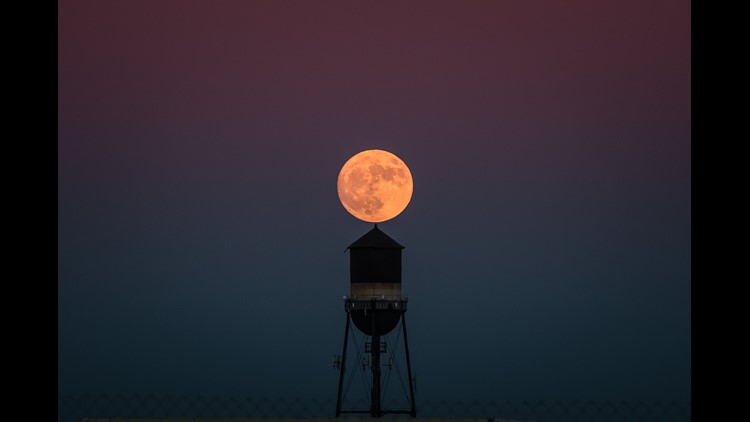On Sunday, stargazers, astronomers and curious sky-watchers will get a chance to witness the first and only supermoon of 2017.
In November 2016, the moon reached a distance closest to the Earth than ever seen since 1948, producing a supersized supermoon. However, on Sunday night, the moon will still shine 16% brighter and appear 7% larger than its usual size.
A supermoon occurs when the sun, moon and Earth align, and a full or new moon aligns with the sun’s lunar orb. This supermoon will be the first in the series of three consecutive full moon supermoons, the next two to occur in January.
While it has been a year since a visible supermoon last lit up the sky, everyone in the world has a chance to marvel at this upcoming full moon. Most astronomers suggest watching the supermoon right after sunset and into moonrise, and minutes before the next sunrise as well.
But for those who can’t wake up that early, the moon will still look bigger — and brighter — throughout the night.
The science behind the supermoon
According to Michelle Nichols, director of public observing at Chicago’s Adler Planetarium, there is a reason behind the moon’s captivating close approach to the Earth.
“The moon’s orbit is not a perfect circle. It’s more like an oval, so at times it’s closer to the Earth than it is at other times. The difference in distance between these close and far points can be as much as about 30,000 miles.”
The distance between the moon and Earth constantly changes. Each time the moon orbits the Earth, every 29.5 days, it will reach a close point to the Earth (perigee), and a far point (apogee), and occasionally, the close point will be close to the date of the full moon or new moon, a supermoon.
“For this year’s final supermoon, the perigee distance will be approximately 222,135 miles in the early morning hours of December 4 (in the United States),” says Nichols.
And while it may appear super, the term “supermoon” is not the official term for the astronomical phenomenon. The scientific term is “perigee syzygy.” Perigee syzygy has occurred three previous times in 2017.
However, December’s full moon is the only visible supermoon. This is because the previous two were around the time of a new moon, which isn’t visible in the sky.
Don’t let your eyes fool you
While the moon is undoubtedly both bigger and brighter than usual, our eyes tend to trick us into seeing the moon as larger than it truly is.
Part of it depends on where you’re viewing the supermoon.
“When you look at it from near the horizon, there’s an optical illusion,” says Nichols.
When the supermoon is viewed low on the horizon, it appears huge. This is known as the moon illusion and the moon hasn’t grown; it’s a trick your eyes are playing on you.
This optical illusion also occurs when watching the supermoon immediately after sunset (or before sunrise). At this time, the moon also appears both bigger and brighter than it actually is. This is also why both times are the best for watching the supermoon.
Nichols says that despite the difference between a regular full moon and a supermoon, it is not as grand as it appears.
“If you stretch out your arm at full length, and stretch out your thumb, and compare the size of the full moon in the sky to the size of your thumb, you’ll notice the width of the full moon compared to the size of your thumb; you can put four full moons across the width of your thumb.”
Considering that a full moon can be covered with a fingernail, even a 7% larger moon may not look that much bigger.
How to photograph the supermoon
For everyone waiting to catch a glimpse of the last supermoon of 2017, taking pictures to preserve the moment can be easy.
Bill Ingalls, a NASA photographer, says that those capturing the event through their smartphones have to focus on the correct light balance.
“Tap the screen and hold your finger on the object (in this case, the moon) to lock the focus. Then slide your finger up or down to darken or lighten the exposure.”
For those using DSLR cameras, Ingalls recommends using another subject in the image, like a person, pet or landmark to compare to the size of the moon.
“Often I find when the moon is near the horizon I have a better chance of incorporating it with a landmark or person, but there are no rules and sometimes a tall object such as the Washington Monument here in D.C. can be used when the moon is at a very high angle.
While the supermoon can come out looking larger in photos (thanks to long lenses and editing) than it does when looking at it in person, Nichols says it is an incredible opportunity to get people interested in science and astronomy.
“The supermoon gets headlines because the moon’s a little bigger and a little brighter, but people get frustrated that they can’t always tell the difference. Still, it’s a great excuse to just go out and look at the sky,” says Nichols.
“You can do the experiment with your outstretched thumb. Do it near the horizon, and do it again away from the horizon. Then do it somewhere else. It’s a fun way to get involved in science.”



